Our editor-in-chief Nate Yapp is proud to have contributed to the new book Hidden Horror: A Celebration of 101 Underrated and Overlooked Fright Flicks, edited by Aaron Christensen. Another contributors include Anthony Timpone, B.J. Colangelo, Dave Alexander, Classic-Horror.com's own Robert C. Ring and John W. Bowen. Pick up a copy today from Amazon.com!
Death with a Brutal Kick: 10 Sadistic Ways to Die in a Horror Movie
Sometimes, we get contacted to do an article to coincide with the release of a theatrical film or DVD. Most of the time, we don't do it because we either don't have any ideas or there are no good ideas for that particular movie. The PR folks for Universal's recent remake of The Hitcher (coming out on DVD May 1st -- check the cover art at the bottom of the page) had something different, however -- a good idea. They said, "Hey, guys, we have somebody getting yanked apart by two semi trucks in our movie. What about listing off some other brutal and/or sadistic deaths?" I was intrigued, which is often enough to get me to put fingers to keyboard, so here we go.
The list presented below isn't definitive. These aren't necessarily the ten most brutal or sadistic deaths in a horror movie, just the ones we thought were notable. Your mileage may vary. Each entry is accompanied by a screencap that can be accessed by clicking the thumbnail icon below the film title.
The Black Cat (1934)
| This particular scene from Edgar G. Ulmer's directorial debut stands out as one of the nastier deaths from the golden age of the horror film (Dr. Moreau's vivisection in Island of Lost Souls also bears mentioning). As revenge for suffered due to the treachery of Hjalmar Poelzig (Boris Karloff), Dr. Werdegast (Bela Lugosi) ties his nemesis to the rack and begins to take off his skin "bit by bit" with a scapel. The act itself is seen only in silhouette, but it is shocking all the same. There is a tendency to view the 1930s and 40s as "safe" periods of non-explicit horror, but films like The Black Cat prove that sadism can appear at any point in film history. |
Black Sunday (1960)
| This one is quick and to the point. Witch Asa Vajda (Barbara Steele) is condemned to death. Since she's in cahoots with the devil, it's no simple stabbing or hanging for her. First she is branded with an 'S' (the Mark of Satan), painful, but hardly the worst fate in store for her. Next, the Mask of Satan is placed on her face. This nasty number has large, wicked spikes on the inside. To drive the point home, so to speak, the executioner hammers the mask onto Asa's face, causing rivulets of glorious black & white blood to pour from the eye holes. The death is over in a flash, but the image lingers forever. |
Psycho (1960)
| Now here’s a death sequence you could talk about forever. The shower scene in Psycho (’60) is probably the most famous kill in all of cinema. It’s one of those scenes that have been burned into our culture’s conscious whether or not you’ve actually seen the whole movie, like King Kong climbing the Empire State Building. We’ve followed Marion Crane from the film’s beginning. She has stolen a large amount of money, but we’ve come to identify with her, thanks to clever storytelling. Suddenly, halfway through the movie, just after she has made the decision to right her wrong, Hitchcock unapologetically has her killed at the hands of Norman Bates’ mother. In fact, when the moment arrives, everything happens so fast that your imagination overcompensates for the scene’s actual lack of gore. The celebrated scene is made up of over ninety quick edits, none of which actually portray any graphic violence. In it, Norman’s mother pulls the shower curtain on the naked, helpless Marion and stabs her repeatedly and relentlessly. All she can do is scream and hopelessly grab her attacker’s wrist while her own blood splatters the wall. The sound here also works to great effect. There is a cringe-worthy visceral stabbing sound, and, more importantly, there is Bernard Herrmann’s shrill score, which perfectly evokes the terror of being stabbed repeatedly and decisively. All of this works to creative a truly horrifying and frenetic experience, an experience that was even more shocking to its original audiences who had no idea to expect it. Then, when it’s over, after Marion slowly falls to the floor, she reaches to the audience, but the camera backs away. After the shower curtain has ripped from its rings as she grasped it, we simply watch her blood spiral down the drain with the water that was meant to purify her. |
Last House on the Left (1972)
| The stabbing of Phyllis (Lucy Grantham) may be little more than a repulsive death scene in a repulsive film, but that repulsion is borne on the wings of brutality. After escaping from psychopath Krug (David Hess) and his sadistic clan, Phyllis is run ragged through the woods before the gang catches up with her. As Krug holds her still, his right-hand man Weasel knifes her in the stomach multiple times before a violently enraged Sadie (Jeramie Rain) gets her turn. Sadie stabs Phyllis in the side again and again until she starts pulling intestines. As with the rest of Last House on the Left, the sequence is shot in a shaky documentary style, heightening the reality of the moment until it sickens. Director Wes Craven has stated that Last House was his reaction to the violence of the Vietnam War. If he accomplished nothing else in the film, he at least captured that senseless horror in this sequence. |
The Wicker Man (1973)
| The image is impossible to escape -- an gigantic man-shaped figure made of wood. However, if you know what it represents, there's no need to rehash it, and if you don't know, I won't ruin it for you. Suffice to say, it is probably the only terrifying death to ever occur to the tune of joyful folk singing. |
The Texas Chain Saw Massacre (1974)
| There was some minor debate on exactly which death to include from Tobe Hooper's masterpiece. Robert Ring argued for the first death -- that quick hammer to the head out of nowhere -- but my vote goes for the second slaying in the film. Pam (Teri McMinn) has gone searching for her boyfriend after he fails to return from the decrepit house they've discovered. She wanders into the house, only to discover a room filled with feathers and furniture made of bone. However, her escalating terror is cut short by Leatherface (Gunnar Hansen), who snatches her up, takes her to the kitchen, and hoists her on a meathook. Thunk. Right into the spine. Like Black Sunday, it's a scene that reminds us that brutality is sometimes quick and it's usually merciless. |
Deep Red (1975)
| Technically, the really brutal parts of this scene don't kill the victim, but we'll let it slide because the actual method of dispatch comes soon after and it's not a walk in the park by any means. Professor Giordani (Glauco Mauri) has stumbled onto information that may help identify the killer stalking the hero. However, before he can relay this information, he is beset by... a mechanical doll? The doll, creepy though it may be, is merely a distraction. The killer attacks Giordani from behind. Grabbing the back of the professor's head, the killer slams his teeth into the corner of his fireplace's stone mantle, then continues the dental assault by introducing Giordani's choppers to the corner of his wooden desk. Finally, the killer finishes the job with a knife to the spinal cord. This sequence is particularly effective for the reality of its violence. Director Dario Argento's films seem to exist in a land of exaggeration and hyperbole, so his effectiveness is bolstered when he brings in a real, relatable kind of trauma (and who hasn't bumped their front teeth against something unpleasant?) |
The Beyond (1981)
| This was a tough call. Each director is limited to one entry on the list, but keeping it to just one death for The Beyond proved nearly impossible. So many brilliant ways to die in this film, each one nastier than the last. Given director Lucio Fulci's fondness for ocular trauma, however, I had to give this to the scene where the zombie Joe (Giovanni De Nava) pushes Martha (Veronica Lazar) headfirst into the blunt end of a nail, popping out her eye in the process. It's disgusting, it's over-the-top, but Fulci has a unique ability to take such cinematic hyperbole and make it stick. I know my eye hurts a little every time I watch that scene. |
Day of the Dead (1985)
| George A. Romero's another director who has too many unrelenting death scenes to choose from. Ultimately, our selection acts as an avatar, a representation of all brutalities in Romero's oeuvre. In this example, slaughter couldn't happen to a meaner guy. Captain Rhodes (Joe Pilato) is one mean son-of-a-bitch who hates zombies, scientists, and probably kittens. When the zombies run rampant over his military base, he goes to arm himself, but before he can get a clip in his rifle, he's shot numerous times by Bub (John Howard), a semi-intelligent zombie. Crawling away, he opens a door only to discover a whole bunch of zombies waiting to eat his tender flesh. He's literally torn to pieces, but as the undead eat his intestines, he admonishes them to "choke on 'em." Here the brutality is a welcome end to a hated villain, even if it churns the stomach a bit. |
Saw (2004)
| Saw and its sequels know vicious death. Worse, they present their painful tortures of the flesh as largely self-inflicted, so there's a lingering question of "Could I do this to myself given these circumstances?" Of course, even asking that question invites you to consider how much it would hurt, how much you could withstand, whether you would die... Thus, the Saw films attack the viewer from both a visceral and philosophical standpoint, but the end result is the same -- watching them invites sympathy pains. The pains are particularly nasty during this sequence, where a middle-aged man who recently attempted to slit his wrists is forced to work his way out of a cage filled with razor wire. He doesn't succeed, but he does manage to embed the wire so deeply he actually spills his own stomach acid on the ground. There's man's brutality to man and then there's man's brutality to self. If you want my opinion, the latter can be far, far worse. |
Agree? Disagree? I suspect that each person has their own list and that it may be completely different from the one presented here. For instance, I have completely neglected Italy's "cannibal" subgenre, since I am largely unfamiliar with it. If you have suggestions for future revisitations of this list, please leave a comment below.




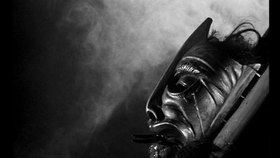


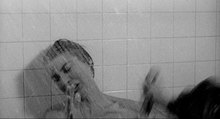


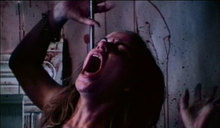


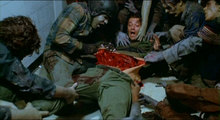
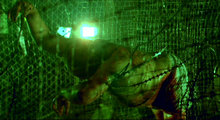





I'm a bit surprised that you
I'm a bit surprised that you don't mention any asian death scenes. In my opinion, Suicide Circle shows man's brutality to self far better than Saw. I also think the abortion scene in Dumplings deserves mention.
lol koool i love the saw one
lol koool i love the saw one saw is one of the best movies ever
cannibal hollocaust is so
cannibal hollocaust is so much better